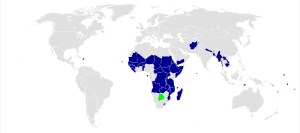Least developed country

A least developed country (LDC) is a country that the United Nations considers to be the least developed out of all the countries in the world. They normally have the lowest ratings on the Human Development Index. The idea to name LDCs started in the late 1960s. The first group of LDCs was listed by the UN in November 1971.[1]
Classification process[change | change source]
Indicators are used to determine whether a country is a least devleoped country.
- The gross domestic product, per person, is low. Currently, the average over three years is considered.
- An index measuring social factors, such as health, education and literacy among adults. Currently, the Human Assets Index is used for this purpose.
- A third index looks at how vulnerable the economy is as a whole. Currently, the Economic Vulnerability Index is used.
To be considered a least developed country, a country must have high levels of poverty and infant mortality, low human resources and a vulnerable economy.[2] The UN looks at indicators, such as gross national income, nutrition, health, education and literacy. Economic vulnerability is recorded on the Economic Vulnerability Index.
LDC criteria are reviewed every three years. Countries may stop being considered an LDC when indicators show that they have become developed enough. Since the LDC category was created, four countries have graduated to developing country status.[3][4] The first country to do this was Botswana in 1994. The second was Cape Verde, in 2007.[5] Then Maldives in 2011, and Samoa in 2014.[6][7] It is expected that Equatorial Guinea and Vanuatu will be the next countries to be promoted from LDC status.[8]
As of 2014[update], there are 48 least developed countries.[9] There are also three countries which meet the criteria for LDC status, but have asked to not be included in the index: Ghana, Papua New Guinea and Zimbabwe.[10]
Current list[change | change source]
The "least developed countries" according to the United Nations:
- Africa (34 countries)
 Angola
Angola Benin
Benin Burkina Faso[11]
Burkina Faso[11] Burundi[11]
Burundi[11] Central African Republic[11]
Central African Republic[11] Chad[11]
Chad[11] Comoros[12]
Comoros[12] Democratic Republic of the Congo
Democratic Republic of the Congo Djibouti
Djibouti Equatorial Guinea
Equatorial Guinea Eritrea
Eritrea Ethiopia[11]
Ethiopia[11] Gambia
Gambia Guinea
Guinea Guinea-Bissau[12]
Guinea-Bissau[12] Lesotho[11]
Lesotho[11] Liberia
Liberia Madagascar
Madagascar Malawi[11]
Malawi[11] Mali[11]
Mali[11] Mauritania
Mauritania Mozambique
Mozambique Niger[11]
Niger[11] Rwanda[11]
Rwanda[11] São Tomé and Príncipe[12]
São Tomé and Príncipe[12] Senegal
Senegal Sierra Leone
Sierra Leone Somalia
Somalia South Sudan
South Sudan Sudan
Sudan Tanzania
Tanzania Togo
Togo Uganda[11]
Uganda[11] Zambia[11]
Zambia[11]
- Asia (9 countries)
 Afghanistan[11]
Afghanistan[11] Bangladesh[13]
Bangladesh[13] Bhutan[11]
Bhutan[11] Cambodia
Cambodia East Timor[12]
East Timor[12] Laos
Laos Myanmar
Myanmar Nepal[11]
Nepal[11] North Korea
North Korea Syria
Syria Turkmenistan
Turkmenistan Yemen
Yemen
- Oceania (4 countries)
- Americas (1 country)
Related pages[change | change source]
- Developed country
- Developing country
- Global Hunger Index
- Third world
- List of countries by Human Development Index
- Poverty line
- Small Island Developing States
References[change | change source]
- ↑ General Assembly resolution 2768 (XXVI) Archived 2011-07-09 at the Wayback Machine (PDF)
- ↑ UN-OHRLLS Criteria for Identification and Graduation of LDCs Archived 2019-07-25 at the Wayback Machine.
- ↑ "Delegates in Preparatory Meeting Express Concern about Shortage of Countries 'Graduating' from Least-Developed Status over Last Decade". Mmdnewswire.com. Archived from the original on 2015-10-17. Retrieved 2014-07-28.
- ↑ "Istanbul forum offers chance to recommit to helping world's poorest nations". Un.org. 2011-01-10. Retrieved 2014-07-28.
- ↑ "UN advocate salutes Cape Verde’s graduation from category of poorest States", UN News Centre, 14 June 2007.
- ↑ "Maldives identifies challenges in graduating to a developing country" Archived 2010-11-29 at the Wayback Machine, UN-OHRLLS, 23 December 2010
- ↑ "Samoa To Gain Developing Country Economic Status In January 2014". UN-OHRLLS. Archived from the original on 2015-10-17. Retrieved 2015-08-09 – via Radio Australia.
- ↑ "List of least developed countries" (PDF). United Nations. Retrieved 2015-08-09.
- ↑ "About LDCs". Least Developed Countries. UN-OHRLLS. Archived from the original on 2014-10-08. Retrieved 2014-01-24.
- ↑ "UN Handbook on the LDC Category" (PDF). Retrieved 2014-07-28.
- ↑ 11.00 11.01 11.02 11.03 11.04 11.05 11.06 11.07 11.08 11.09 11.10 11.11 11.12 11.13 11.14 Also a landlocked developing country
- ↑ 12.0 12.1 12.2 12.3 12.4 12.5 12.6 12.7 Also a Small Island Developing State
- ↑ UN-OHRLLS About LDCs Archived 2014-10-08 at the Wayback Machine. Retrieved 2015-12-12.
- ↑ Country profiles Archived 2011-05-17 at the Wayback Machine, Least Developed Countries, UN-OHRLLS. Accessed on line April 16, 2008.
More reading[change | change source]
- United Nations, "LDCs: Least Developed Countries, Landlocked Developing Countries, and Small Island Developing States"
- World Trade Organisation, ""WTO Launches Trade Initiative for Least Developed Countries", FOCUS newsletter, WTO, Geneva, Switzerland, November 1997 issue 24.
